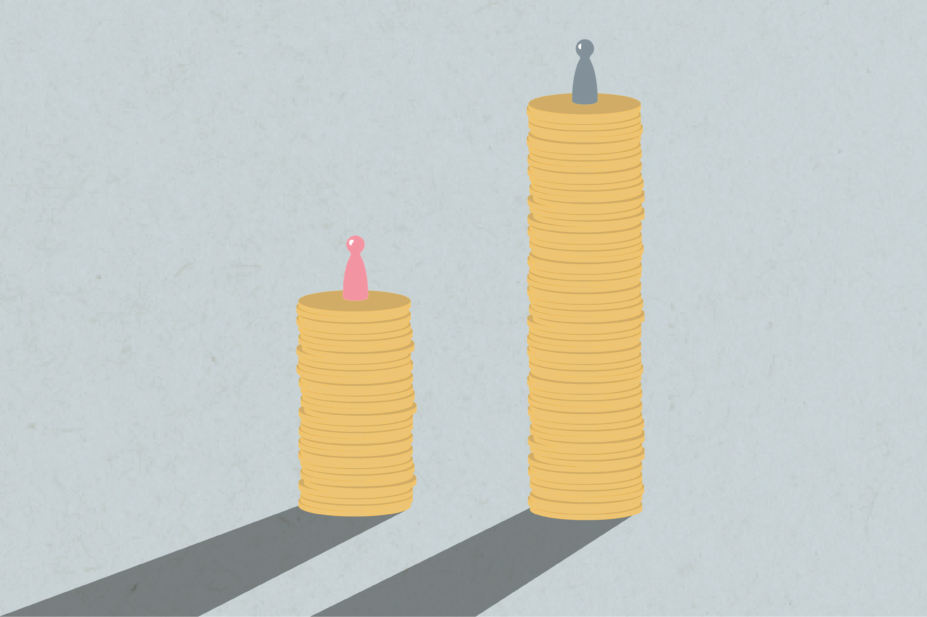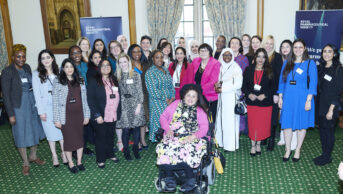
Shutterstock /JL
Female pharmacists in the UK may have long suspected it, but this is the first robust evidence showing that they may be significantly underpaid for the work they do.
Results from a salary and job satisfaction survey, conducted by The Pharmaceutical Journal between July and September 2018, have revealed a significant difference in median pay between male and female non-locum pharmacists of 6.4%.
They come amid unprecedented attention on the gender pay gap in society at large, and show that this is an issue that affects the pharmacy profession too; however, the national median gender pay gap has been falling and is now 8.6% for full-time workers, showing that the differential in the pharmacy profession is smaller in scale.
Nevertheless, the gap in hourly rates for male and female pharmacists is statistically significant, according to the analysis by independent academic statisticians from the University of Aberdeen.
When based on a 40-hour working week, the results from more than 1,100 respondents indicate a median annual salary of £51,376 for male pharmacists compared with £48,048 for their female counterparts — a difference of £3,328.
Bigger picture
This gender pay gap is similar to that reported by other large pharmacy employers. LloydsPharmacy reported a median gender pay gap of 6% for all professional and managerial roles, while Boots reported a median gender pay gap of 5% in March 2018. Rowlands, Day Lewis, Superdrug, Cohens and Paydens also reported substantial gender pay gaps when calculated by hourly rate.
Those large companies had to divulge the information as part of new government rules for all businesses employing more than 250 people, but some smaller pharmacy organisations have decided to voluntarily publish their gender pay gap figures. For instance, the General Pharmaceutical Council published a median gender pay gap of 16.5%.
Table 1: Median hourly pay for male and female non-locum pharmacists
| Male (n=375) | Female (n=734) | Total (n=1109) | Pay gap per hour | P-value | |
|---|---|---|---|---|---|
* Statistical analysis was conducted using the Mann-Whitney test. Source: The Pharmaceutical Journal Salary and Satisfaction Survey 2018. The survey was conducted between 16 July and 3 September 2018. Invitations were sent to 26,785 pharmacist members of the Royal Pharmaceutical Society. Statistical differences were analysed by the non-parametric Mann-Whitney test and were conducted by independent academic statisticians at the University of Aberdeen. | |||||
Hourly rate (GBP) (median, interquartile range) | 24.7 (20.7, 30.4) | 23.1 (19.2, 27.8) | 23.7 (19.7, 28.5) | 1.60 | 0.001* |
The figures come after research from the University of Birmingham in March 2018 revealed that only 36% of UK female pharmacists hold the most senior positions, which sparked the ‘Mind the Gap’ campaign by The Pharmaceutical Journal to explore the issue. The Royal Pharmaceutical Society (RPS) has also been active, holding a Women in Pharmacy seminar and announcing two prizes for women in pharmacy and the pharmaceutical sciences in June 2018.
In medicine, there is a gap of £10,000 between average earnings for male and female doctors. The Department of Health has launched a review after calls from the British Medical Association to investigate the drivers behind this and the barriers that stop women from being underrepresented in the top jobs.
Analysing the gap
It is, of course, illegal to pay men and women differently for doing the same job, but factors such as women doing more of the less well-paid jobs within a company, taking time out for family or caring commitments, and being less well represented in the most senior positions all contribute to the gap seen in pay between the genders in the UK.
Christine Heading, an academic pharmacist and executive committee member of the National Association of Women Pharmacists, says the results of the survey show how much progress the pharmacy profession needs to make to ensure fairness to female employees: “There is widespread ignorance from top to bottom about existing theories and findings concerning gender issues within professions, including the health professions.”
She believes that pharmacy is guilty of burying its head in the sand about the problem. “This manifests in failure to collect data on career progression, salaries, obstacles, challenges, attitudes and performance on a gender basis.
“It may also be relevant to wellbeing issues where support may need to recognise differences between genders, so that neither is disadvantaged.”
Heading has observed a “huge gulf” in how gender issues are dealt with in pharmacy, compared with other sectors, such as higher education and in industry, and adds that the notoriously poor gender equality position in the retail sector may have had an influence in the multiple community pharmacy chains.
One is the result of a rational choice by a proportion of women who chose to put career advancement plans on hold for a few years after children are born
The reasons for the gap between pay for male and female pharmacists are multifactorial but there are two main aspects that stand out to Heading: “One is the result of a rational choice by a proportion of women who chose to put career advancement plans on hold for a few years after children are born.” She says there is no UK evidence to show whether this is a disadvantage in the long term, although adds: “Some other countries have taken steps to ensure it does not.”
Sandra Gidley, chair of the RPS English Pharmacy Board, said it is not surprising there is a gender pay gap in pharmacy, but she would be interested to see more detailed data on how much of the variation is within pharmacists at equal grading and how much could be explained by more men being in senior positions.
“[At the RPS] we have not done any profession-wide research but we do have concerns,” she says. Gidley believes that the results show pharmacy has to work as hard as other professions to seriously address the problem. “It means that the pharmacy profession is no different to any other profession in as much as the gender balance at the ‘top’ of the profession does not reflect the gender balance at entry level.”
Being transparent
Gidley adds that any profession that shows transparency over the gap, and is clearly serious about addressing it, will be able to attract the most capable female graduates in the future. Young people are now actively looking at professions and choosing those in which women appear to be treated equally. “We clearly have a problem when all of the major pharmacy organisations now have male chief executives and, apart from the RPS, many organisations have very few women on their boards.”
Gidley — who also works as a self-employed locum pharmacist — says the figures provided by the survey respondents certainly reflect her experience in the pharmacy workplace. “I am saddened because I thought that the battles I had to fight, early on in my career, appear to be the same as those being fought by my daughter’s generation.”
Women still too frequently undervalue themselves and are not great at asking for more money
Yet while there is much that pharmacy as a profession can do to change the status quo, much of the problem is a cultural one across the UK. “Women still too frequently undervalue themselves and are not great at asking for more money, and until there is much more transparency about pay levels we will not be able to move to a more equitable position.” However, Gidley says this is a societal problem and not purely a pharmacy one, and the RPS has no powers to force employers to be more transparent.
She points to the RPS Women and Pharmacy initiative as a strong starting point to address some of the underlying issues. “I would like to see [the campaign] go from strength to strength and it is encouraging to see other organisations following in our footsteps. We already have a mentoring scheme but we can only do so much.”
She adds: “I will say this though — the RPS recently advertised a number of senior positions and the number of male applicants far outnumbered the women.”
Gidley’s says women should stop thinking of why they should not apply for roles and just go for it — there will be knockbacks but there are lessons to be learnt from them.
“I look forward to building on the women and pharmacy initiative and using the awards to highlight the stories of inspirational women.” But she adds: “We can provide mentorship and support but ultimately it is down to employers of pharmacists in all settings to be transparent about their pay levels.”
Zoe Long, director of communications and public affairs at the Pharmaceutical Services Negotiating Committee, says the association is committed to treating all employees fairly and equally, as it hopes would be the ambition of all organisations.
“Our objective is to negotiate the best funding deals possible so that community pharmacies can continue to deliver high-quality services to patients and local communities and in doing so offer a range of flexible career options for all employees.”
Leyla Hannbeck, director of pharmacy at the National Pharmacy Association, says women do get to the top of their profession in pharmacy organisations but the data from The Pharmaceutical Journal survey shows men do so more often.
“Pharmacy’s not unique in that respect and these figures reflect wide-ranging and incredibly complex societal issues.”
She adds that family dynamics have changed, and with adult social care and the ageing population becoming an increasing concern, they will change again. “There are no easy answers but employers must adapt as best they can to support employees’ choices and responsibilities while nurturing their talent.”
Box: What to do if you are underpaid
If you feel you are not being paid fairly because of your gender, or for any other reason, you can seek advice from the sources below:
-
RPS Professional Support Service: 020 7572 2737. The RPS Professional Support Service is a confidential advice service that you can contact as part of your membership; - Acas provides information, advice, training, conciliation and other services for employers and employees to help prevent or resolve workplace problems: www.acas.org.uk/recruitment;
- How to ask for a pay rise. Pharm J 2018;301(7915):54–56. doi: 10.1211/PJ.2018.20205102



